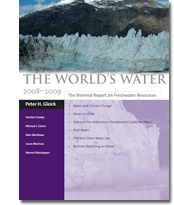 Lake Tai, the center of China’s ancient “land of fish and rice,” succumbed this year to floods of industrial and agricultural waste.
Lake Tai, the center of China’s ancient “land of fish and rice,” succumbed this year to floods of industrial and agricultural waste.View this NY Times feature on the environmental impacts of growth in China.
 Lake Tai, the center of China’s ancient “land of fish and rice,” succumbed this year to floods of industrial and agricultural waste.
Lake Tai, the center of China’s ancient “land of fish and rice,” succumbed this year to floods of industrial and agricultural waste.

 Science Daily describes an epic drought during the mid-1100s that dwarfs any drought previously documented for a region that includes areas of Arizona, Colorado, New Mexico, Utah and Wyoming.
Science Daily describes an epic drought during the mid-1100s that dwarfs any drought previously documented for a region that includes areas of Arizona, Colorado, New Mexico, Utah and Wyoming. In Teeming India, Water Crisis Means Dry Pipes and Foul Sludge
In Teeming India, Water Crisis Means Dry Pipes and Foul Sludge
 Colorado River Basin Water Management: Evaluating and Adjusting to Hydroclimatic Variability
Colorado River Basin Water Management: Evaluating and Adjusting to Hydroclimatic Variability Drinking Water: Understanding the Science and Policy behind a Critical Resource, by the National Academies
Drinking Water: Understanding the Science and Policy behind a Critical Resource, by the National Academies Total Water Management: Practices for a Sustainable Future by: Neil S. Grigg, PhD, PE
Total Water Management: Practices for a Sustainable Future by: Neil S. Grigg, PhD, PE The new Brookings Institute report Double Jeopardy focuses on two of the most pressing challenges for global policymakers: reducing global poverty and stabilizing the Earth's climate. Developed following in-depth discussions with leading experts from the climate change and development arenas, including former Vice President Al Gore and Dr. Steven Chu, the new U.S. Secretary of Energy, the report details the need for new global policies that address the interrelated nature of climate change and global poverty issues.
The new Brookings Institute report Double Jeopardy focuses on two of the most pressing challenges for global policymakers: reducing global poverty and stabilizing the Earth's climate. Developed following in-depth discussions with leading experts from the climate change and development arenas, including former Vice President Al Gore and Dr. Steven Chu, the new U.S. Secretary of Energy, the report details the need for new global policies that address the interrelated nature of climate change and global poverty issues.
 As rivers run dry and fields turn to dust, China has announced dramatic plans to cut water use by industry and agriculture.
As rivers run dry and fields turn to dust, China has announced dramatic plans to cut water use by industry and agriculture.
 Water Information Center is a resource for scientists, managers and researchers around the world with access to over 100 water-related reports from the National Academies.
Water Information Center is a resource for scientists, managers and researchers around the world with access to over 100 water-related reports from the National Academies.
 Engineers Without Borders - USA is a non-profit humanitarian organization established to partner with developing communities worldwide in order to improve their quality of life. This partnership involves the implementation of sustainable engineering projects, while involving and training internationally responsible engineers students.
Engineers Without Borders - USA is a non-profit humanitarian organization established to partner with developing communities worldwide in order to improve their quality of life. This partnership involves the implementation of sustainable engineering projects, while involving and training internationally responsible engineers students.


